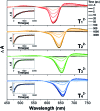Switchable π-electronic network of bis(α-oligothienyl)-substituted hexaphyrins between helical versus rectangular circuit
- PMID: 29910912
- PMCID: PMC5977443
- DOI: 10.1039/c5sc04263a
Switchable π-electronic network of bis(α-oligothienyl)-substituted hexaphyrins between helical versus rectangular circuit
Abstract
The switching phenomena of conformation with π-electronic network through deprotonation-protonation processes were investigated by employing a series of 5,20-bis(α-oligothienyl) substituted hexaphyrins(1.1.1.1.1.1). They showed significant changes in the absorption and emission spectra with deprotonation, and returned to the initial state with protonation. Through NMR measurements and single crystal X-ray diffraction analysis, we found that the 5,20-bis(α-oligothienyl) substituted hexaphyrins, which possess acyclic, helical electronic networks involving oligothienyl chains in dumbbell conformations (type-I) in a neutral form, underwent effective deprotonation upon treatment with tetrabutylammonium fluoride (TBAF) to generate the corresponding dianions, which display cyclic electronic networks with enhanced aromaticity in rectangular conformations (type-II). Our quantum calculation results provide an unambiguous description for the switchable conformation and π-conjugation, which revealed that a deprotonation-induced enhanced aromatic conjugation pathway is involved in the switchable π-electronic network.
Figures







References
-
- Stępień M., Latos-Grażyński L., Sprutta N., Chwalisz P., Szterenberg L. Angew. Chem., Int. Ed. 2007;46:7869. - PubMed
- Tanaka Y., Saito S., Mori S., Aratani N., Shinokubo H., Shibata N., Higuchi Y., Yoon Z. S., Kim K. S., Noh S. B., Park J. K., Kim D., Osuka A. Angew. Chem., Int. Ed. 2008;47:681. - PubMed
- Sankar J., Mori S., Saito S., Rath H., Suzuki M., Inokuma Y., Shinokubo H., Kim K. S., Yoon Z. S., Shin J.-Y., Lim J. M., Matsuzaki Y., Matsushita O., Muranaka A., Kobayashi N., Kim D., Osuka A. J. Am. Chem. Soc. 2008;130:13568. - PubMed
- Yoon Z. S., Osuka A., Kim D. Nat. Chem. 2009;1:113. - PubMed
-
- Pacholska-Dudziak E., Skonieczny J., Pawlicki M., Szterenberg L., Ciunik Z., Latos-Grażyński L. J. Am. Chem. Soc. 2008;130:6182. - PubMed
- Higashino T., Lim J. M., Miura Y., Saito S., Shin J.-Y., Kim D., Osuka A. Angew. Chem., Int. Ed. 2010;49:4950. - PubMed
- Higashino T., Lee B. S., Lim J. M., Kim D., Osuka A. Angew. Chem., Int. Ed. 2012;51:13105. - PubMed
-
- Koide T., Kashiwazaki G., Suzuki M., Furukawa K., Yoon M.-C., Cho S., Kim D., Osuka A. Angew. Chem., Int. Ed. 2008;47:9661. - PubMed
- Rath H., Tokuji S., Aratani N., Furukawa K., Lim J. M., Kim D., Shinokubo H., Osuka A. Angew. Chem., Int. Ed. 2010;49:1489. - PubMed
- Koide T., Furukawa K., Shinokubo H., Shin J.-Y., Kim K. S., Kim D., Osuka A. J. Am. Chem. Soc. 2010;132:7246. - PubMed
- Gopalakrishna T. Y., Reddy J. S., Anand V. G. Angew. Chem., Int. Ed. 2014;53:10984. - PubMed
- Tanaka Y., Yoneda T., Furukawa K., Koide T., Mori H., Tanaka T., Shinokubo H., Osuka A. Angew. Chem., Int. Ed. 2015;54:10908. - PubMed
- Hisamune Y., Nishimura K., Isakari K., Ishida M., Mori S., Karasawa S., Kato T., Lee S., Kim D., Furuta H. Angew. Chem., Int. Ed. 2015;54:7323. - PubMed
LinkOut - more resources
Full Text Sources
Other Literature Sources
Research Materials
Miscellaneous

